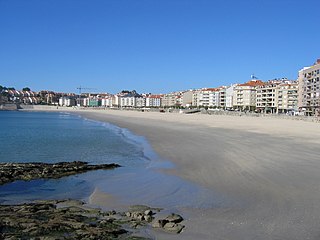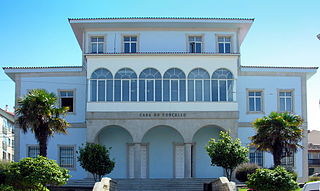
Galicia is an autonomous community of Spain and historic nationality under Spanish law. Located in the northwest Iberian Peninsula, it includes the provinces of A Coruña, Lugo, Ourense, and Pontevedra.

Ourense is a province of Spain, in the southeastern part of the autonomous community of Galicia. It is bordered by the provinces of Pontevedra to the west, Lugo to the north, León and Zamora, to the east, and by Portugal to the south. With an area of 7,278 square km., it is the only landlocked province in Galicia. The provincial capital, Ourense, is the largest population centre, with the rest of the province being predominantly rural.

Pontevedra is a city in the autonomous community of Galicia, in northwestern Spain. It is the capital of both the Comarca and Province of Pontevedra, and the capital of the Rías Baixas. It is also the capital of its own municipality which is often considered an extension of the actual city.

Vigo is a city and municipality in the province of Pontevedra, within the autonomous community of Galicia, Spain. Located in the northwest of the Iberian Peninsula, it sits on the southern shore of an inlet of the Atlantic Ocean, the Ria de Vigo, the southernmost of the Rías Baixas. It is the capital of the comarca of Vigo.

A Coruña is a city and municipality in Galicia, Spain. It is Galicia's second largest city, behind Vigo. The city is the provincial capital of the province of A Coruña, having also served as political capital of the Kingdom of Galicia from the 16th to the 19th centuries, and as a regional administrative centre between 1833 and 1982.

Lugo is a city in northwestern Spain in the autonomous community of Galicia. It is the capital of the province of Lugo. The municipality had a population of 98,025 in 2018, making it the fourth most populous city in Galicia.

São Vicente is a coastal municipality in southern São Paulo, Brazil. It is part of the Metropolitan Region of Baixada Santista. The population is 329,911 in an area of 148,151 square kilometres.

San Cibrao, is an industrial and fishing town, part of Cervo in Northwestern Spain. The population of San Cibrao is about 3,000 in July and August and about 2,000 year-round.

Ponteareas is a town and municipality in the province of Pontevedra, in the autonomous community of Galicia, Spain. It belongs to the comarca of O Condado.

Sanxenxo is a municipality in Galicia, Spain in the province of Pontevedra.

Porto do Son is a municipality in the province of A Coruña, in the autonomous community of Galicia, Spain. It belongs to the comarca of Noia. The municipality of Porto do Son encompasses a collection of coastal towns and villages in from including the town of Porto do Son itself, and other towns such as Portosín. The area is around 25 km by 6 km and has many beaches along with some famous Celtic ruins, the castro called the "Castro de Baroña".

Valdoviño is a municipality in the province of A Coruña in the autonomous community of Galicia in northwestern Spain. It is located in the comarca of Ferrol. Valdoviño has a population of 6,926 inhabitants.

Cambre is a municipality in the Province of A Coruña, in the autonomous community of Galicia in northwestern Spain. It is located 12 km from the capital city of A Coruña and ten minutes away from the city's airport, Alvedro.

Fisterra is a municipality in the province of A Coruña, in the autonomous community of Galicia, Spain. It belongs to the comarca of Fisterra. Fisterra is on Cape Finisterre, an alternative final destination for pilgrims on the Way of St. James who seek to travel beyond Santiago de Compostella.

Narón is a municipality in northwestern Spain in the autonomous community of Galicia. It belongs to the comarca of Ferrol.

O Páramo is a municipality in the province of Lugo, in the autonomous community of Galicia, Spain. It belongs to the comarca of Sarria. It has a population of 1632 persons and an area of 74.92 km2.

Ribeira Sacra is a Spanish Denominación de Origen Protegida (DOP) for wines located in the south of the province of Lugo and in the north of the province of Ourense, in Galicia, Spain. It extends over the territories of 20 different municipalities that conform a zone and entity called Ribeira Sacra, which could be translated as "Sacred Shore". The vineyards are planted on the steep slopes of the valleys and canyons of the rivers Miño and Sil. The area acquired official Denominación de Origen status in 1996.

The Fariñeiro or Burro Fariñeiro is a Spanish breed of small domestic donkey indigenous to the autonomous community of Galicia, in north-west Spain. Its name derives from its former use as a pack animal to transport sacks of flour. It may also be referred to as the Spanish: Asno Gallego. It does not have official recognition, and its numbers are severely reduced. It is found mainly in the Península del Morrazo in the province of Pontevedra, in the area surrounding Betanzos in the province of A Coruña, in the comarcas of the los Ancares and O Caurel areas of the province of Lugo and in the mountains of the province of Ourense.

The La Lanzada beach is one of the most famous beaches in Galicia (Spain). It is located in the municipalities of O Grove and Sanxenxo in the province of Pontevedra. The blue flag has been flying there for a long time.

La Toja is an island part of the municipality of O Grove, Galicia, Spain. Located east of the town, it's connected to the mainland by an 18th-century bridge. It has a small urban centre called Illa da Toxa, belonging to the civil parish of San Martín, which had 42 inhabitants in 2018. It has an area of 110 hectares and is located about 30 km from Pontevedra.
























